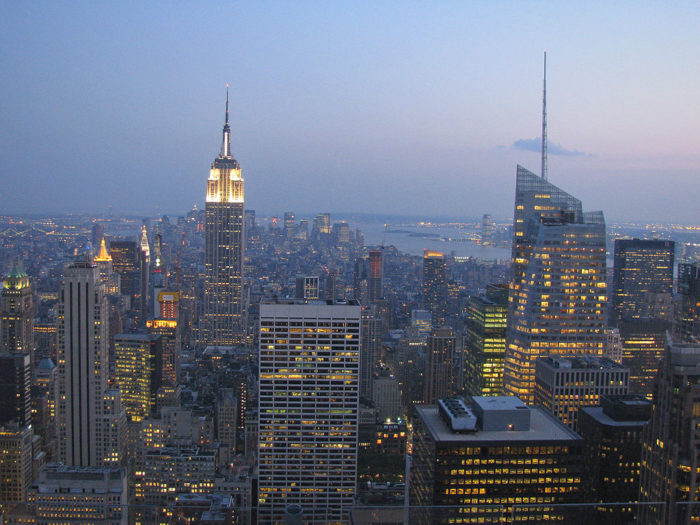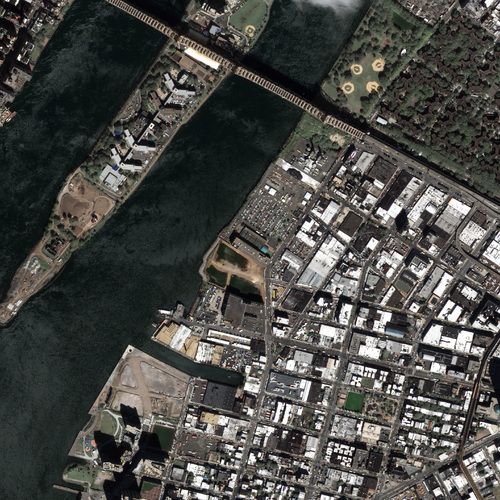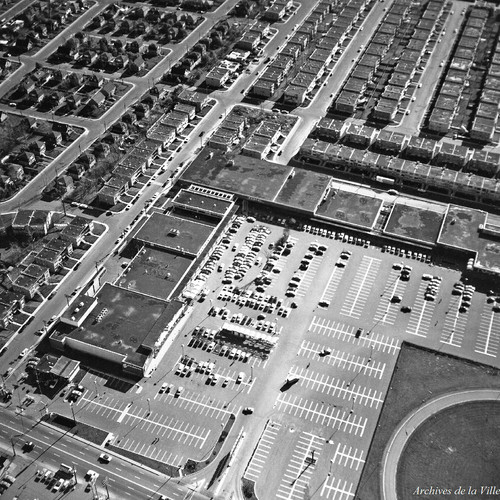
Image Credit: George Miquilena via Wikimedia Commons
The dark, heat-absorbing and impermeable surfaces common to big cities cause a variety of health and environmental problems, including elevated temperatures, lower air quality, and difficulty in managing storm water runoff. The heat island effect, as this phenomenon is called, is part of urban living, but a study by the American Council for an Energy-Efficient Economy (ACEEE) finds that some American cities are rolling out a variety of tactics to fight it.
Researchers sent questionnaires to 26 cities, ranging in size from 3-million-plus Los Angeles and New York to those with less than 1 million in population — places like Austin, Charlotte, and St. Louis. The cities represented Climate Zones 2 through 5.
Motivated by climate change and the need to improve both energy conservation and public health, each city had at least one heat-mitigating strategy even if none of them had formal plans specifically aimed at the problem, the report, Cool Policies for Cool Cities, said.
Most cities had at least one voluntary program affecting private construction, while three-quarters of them had at least one mandatory policy plus a number of broad goals. Building codes requiring cool or green roofs were the most common mandatory policy. Increasing the size of a city’s tree canopy was the most common goal that researchers found.
A chart lists initiatives by city, and indicates whether they are mandatory, voluntary, or simply goals. The report also includes case studies highlighting specific steps that city officials took.
Benefits of lowering temperatures are numerous
The combination of heat-absorbing surfaces, lack of vegetation, and lots of people can make cities much warmer than the surrounding countryside. On average, the report says, urban areas are 7 F° hotter than adjacent rural areas, and the difference can be as high as 20 F°.
“People in cities subject to excess urban heat and extreme heat waves experience a decreased quality of life,” the authors said. “They are less likely to take advantage of outdoor amenities, exercise or interact outdoors. Residents are more likely to suffer from health problems. Energy utility customers may experience higher bills. City priorities compete for thee use of limited resources. Overall, a city is less pleasant when it is excessively hot.”
As a result, cities that have taken steps to reduce heat island effect see a number of benefits, the report said, including lower energy bills for air conditioned buildings and more buildings that are comfortable even without air conditioning. Reflective roofs don’t expand and contract as much as roofs that absorb a lot of heat energy from the sun, so they tend to last longer. Fewer people get sick or die during heat waves when temperatures are lower.
Light-colored, reflective pavement may be 50 to 70 F° cooler than conventional asphalt pavement, the report says, while being both more durable and better for water quality. Reducing the temperature of roofs also has a positive effect, and “cool roof” strategies may be no more expensive than installing a dark roof.
“Because disadvantaged neighborhoods are often the most vulnerable to heat, addressing a city’s UHI can help promote social and environmental equity,” the report said.
Weekly Newsletter
Get building science and energy efficiency advice, plus special offers, in your inbox.















5 Comments
Lack of vegetation and Lots of People...
As Jo Frost says, there is something that can help with this Elephant in the Room: Family Planning!
Birth rates are unrelated to heat islands or urban density
It takes about 2.1 births per woman to maintain population. The birth rates in the US as a whole is less than 2 per woman: http://en.wikipedia.org/wiki/Total_fertility_rate
Birth rates are lower in urban areas than in rural less dense areas, and much lower in developed economies than in lower per-capita energy use countries.
Bringing electric lighting to rural homes has a bigger effect on reducing the fertility rates than almost any other economic upgrade.
Cities are pretty bright low fertility places, and cities have lower per-capita energy use too (lower transportation energy and heating/cooling energy footprints overall.) Rather than concentrating on family planning, URBAN planning that encourages living in the city would be in order.
Response to Dana Dorsett
Dana.
You wrote, "Bringing electric lighting to rural homes has a bigger effect on reducing the fertility rates than almost any other economic upgrade."
I don't know if it qualifies as an "economic upgrade" or a social upgrade, but the other major factor in lowering rural fertility rates is educating girls.
Lights have multiple effects & purposes...
...one of which is to give people (especially the women & girls) more time to read & study. It's not really an "other" factor- electric light & education rates are linked, though some cultures might still opt to keep the girls in the dark (both literally & figuratively.)
http://news.nationalgeographic.com/news/energy/2012/06/120606-low-cost-solar-in-the-developing-world/
Another effect is to give parents the ability to do something ELSE after dark other than work on expanding the child-labor pool. Light enables all sorts of productive activity that would not otherwise happen. Most of us (even most of those living off grid, with the exception of some tribal reservations) in the US have never had to live without light, and thus schedule all activities around the availability of daylight.. And folks in the heat-island cities have the lowest light-poverty rates and can schedule economically / socially productive activity for any time of day. "The city that never sleeps" rings true. (Who the hell can sleep when it's THIS hot- and can somebody PLEASE turn out the lights! ?! :-) )
Narendra Modi's campaign promise to bring enough solar to every home in India to be able to run at least one light all night seems encouraging, for both the educational benefits to the 400 million Indians who don't currently have access to the grid, and to further stem the birth rate in a not-super-rich country with 1.25 billion inhabitants. The increased urbanization and electrification of India over the past 5 decades has brought the overall birth rate in India down dramatically, but it is still running well ahead of replacement rate, unlike most of the already-developed world (and the very restrictive policies in developing China.) If he pulls it off, it's a really big deal!
India is currently one of the top three coal burning countries too (partly the result of historical industry cronyism, partly poor planning), but Modi gets it: Distributed solar keeps the money in India, needs no cooling water, and doesn't ruin the ecology nearly as much as coal mining or coal burning. As the former governor of Gujarat he shepherded in quite a bit of solar, which led to lower power prices and higher grid reliability, and insulated them more than other parts of India from the Indonesian coal-price spike. This makes me believe that the economic development of India has a chance skip the carbon footprint that China's development took, despite the political connections that Coal India had with the prior government, and may never reach the high coal burning levels of team USA (currently #2, behind China). That would be in contrast to projections of many analysts just a few years ago that India would soon surpass the US in total coal consumption. (In practice they can't- coal fired power in India gets curtailed for insufficient cooling water in the driest months, which is just one of many reliability issues even for those ON the grid. And since they can't dig it up as fast as they are burning it, it saps their hard-currency reserves- the Indian economy can't AFFORD to burn more coal than they currently do at any price, since they need the hard currency for better things.
Since the recent election where Modi became the prime minister the Indian solar industry has been a bit over-the top:
http://economictimes.indiatimes.com/markets/stocks/stocks-in-news/solar-power-stocks-see-multi-fold-jump-on-hopes-from-narendra-modi-govt/articleshow/37217764.cms
But it's tempered a bit by the entrenched attiudes of some of the incumbent factions:
http://www.bloomberg.com/news/2014-06-09/india-dumping-duties-risk-choking-modi-s-solar-revolution.html
But these things will sort themselves out. As micro-grid solutions becomes ever more mainstream & cheap in the developed world that hardware can and will be applied at the rural village level. The cheap PV boom is beginning to impart an inflection point in world population growth, as well as atmospheric carbon growth as the poorest folks in the developing world rise out of light & energy poverty.
And it has nothing to do with family planning.
Cooler cities and spiraling savings
Sometimes we get more in the bargain than first thought. If we introduce vegetation or white roofs into the cityscape the city's ambient temperature drops some. There's less a/c load when the ambient temperature drops. Coincidentally, there is less heat from a/c operation itself. (Motors throw off heat.) With less a/c operation those big evaporative towers on the roof work a little less hard. These secondary effects cool further and $ are saved.
Same thing happens if we reduce thermal gain through windows. The heat from the sunshine is diverted instead of being absorbed by the building interior. We still get the sunshine heating effect for the city but we no longer have to add to it by overcoming the unwanted solar gain with air conditioning.
With today's technology such as trees, solar screens, shutters, films, solar grates, and awnings, the solar gain through windows can be substantially reduced. The main problem is not keeping the heat out. Except for the trees, it's adjusting to the new appearance of things with the new window treatments. Developing technology may give us those savings with less change in appearance (ref. LBNL controllable coatings). Whether it will be more cost effective than an awning remains to be seen. Remember 1) Not all windows need be fitted with the same window attachment and 2) We can't just stick a tree anywhere.
Log in or create an account to post a comment.
Sign up Log in